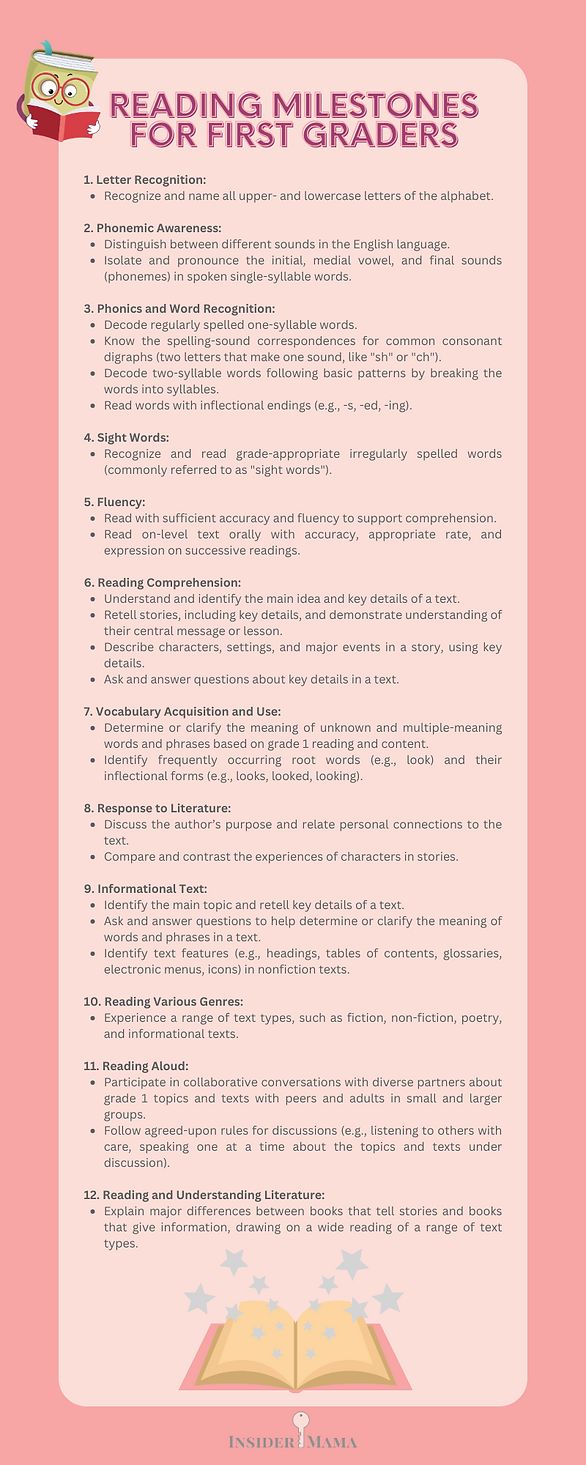So, your little one is stepping into first grade, huh? Welcome to the club where our ‘babies’ suddenly start reading things over our shoulders. (Beware the grocery list that has “ice cream” scribbled on it – they know now!)
Let’s take a few minutes to go over important reading milestones for first graders.

7 Reading Milestones for First Graders
Let’s talk about what reading milestones our first graders should be hitting. It’s a big year for them, and it’s super helpful to know what to expect.
1. Recognizing Letters and Sounds: First graders usually know all the letters and the sounds they make. It’s the foundation for reading, so if your kiddo is still a bit shaky on some letters, it’s a good idea to practice more.
2. Reading Simple Words: They start to read simple words by sounding them out. Think cat, hat, and bat. It’s not just about reading these words in a book; they should be able to spot them in the world around them too.
3. Understanding Basic Sentences: Around this age, kids begin to read and understand simple sentences. They might read, “The cat sat on the mat,” and they get what it means. This is where reading starts to become fun for them, as they see stories unfold.
4. Fluency with Easy Books: Many first graders can read easy books by themselves. These books often have big text and pictures to help with understanding. If your child brings home a book from school, it’s a great chance to let them show off their reading skills.
5. Answering Questions About What They Read: Teachers often ask kids questions about the stories they read to check their understanding. You can do this at home too. Ask them who the story was about or what happened in the end. It’s a great way to chat about what they’re reading.
6. Starting to Write Sentences: Reading and writing go hand in hand. Your first grader might start writing short sentences. They might not spell every word right, but that’s okay. It’s all about getting their ideas down on paper.
7. Growing Vocabulary: Their vocabulary is getting bigger every day. They learn new words from reading, talking, and just being curious little people.
How to Keep Reading Exciting for First Graders
Keeping reading exciting for kids is super important. You want them to see reading as a fun adventure, not just another task. Here are some tips to make reading a blast for your little one:
1. Let Them Choose: Take them to the library or a bookstore and let them pick out books. When kids get to choose what they read, they’re more excited about it. It could be about dinosaurs, space, fairy tales, or anything they’re into.
2. Create a Cozy Reading Spot: Make a special reading nook in your house. It can be a corner with comfy pillows, a blanket, and maybe even some fairy lights. A cozy spot can make reading feel like a special event.
3. Be Dramatic: When you read with them, use funny voices and expressions. It brings the story to life. If you’re having fun, they will too!
4. Incorporate Their Interests: If they’re crazy about a certain topic, find books on that. Love for a subject can fuel love for reading.
5. Reading Rewards: Set up a simple reward system. It could be as easy as a sticker chart. After they read a certain number of books, they get a reward. Maybe a trip to the park or their favorite snack.
6. Family Reading Time: Set aside time where everyone in the family reads. It can be right before bed or on a lazy Sunday afternoon. When they see everyone enjoying a book, they’ll want to join in.
7. Talk About What They Read: Ask them about the stories they read. What was their favorite part? Who was their favorite character? It shows them that their thoughts and opinions about the book matter.
8. Use Technology Wisely: There are tons of reading apps and eBooks that make reading interactive and fun. Just make sure it’s balanced with good old-fashioned books too.
9. Connect Books with Activities: Read a book about baking and then bake together. If they read a book about plants, try gardening. Making connections between books and real life can be super exciting.
10. Regular Library Visits: Make going to the library a regular thing. Many libraries have story hours or reading clubs for kids, which can be a lot of fun.
Remember, the goal is to build a love for reading, not to push them too hard. Keeping it light and fun is the key!
Benchmarks
Reading milestones for first graders in the United States are generally based on educational standards that outline what students should be able to do by the end of the first grade. Here’s a list of specific benchmarks based on common core standards and other educational guidelines:
1. Letter Recognition:
- Recognize and name all upper- and lowercase letters of the alphabet.
2. Phonemic Awareness:
- Distinguish between different sounds in the English language.
- Isolate and pronounce the initial, medial vowel, and final sounds (phonemes) in spoken single-syllable words.
3. Phonics and Word Recognition:
- Decode regularly spelled one-syllable words.
- Know the spelling-sound correspondences for common consonant digraphs (two letters that make one sound, like “sh” or “ch”).
- Decode two-syllable words following basic patterns by breaking the words into syllables.
- Read words with inflectional endings (e.g., -s, -ed, -ing).
4. Sight Words:
- Recognize and read grade-appropriate irregularly spelled words (commonly referred to as “sight words“).
5. Fluency:
- Read with sufficient accuracy and fluency to support comprehension.
- Read on-level text orally with accuracy, appropriate rate, and expression on successive readings.
6. Reading Comprehension:
- Understand and identify the main idea and key details of a text.
- Retell stories, including key details, and demonstrate understanding of their central message or lesson.
- Describe characters, settings, and major events in a story, using key details.
- Ask and answer questions about key details in a text.
7. Vocabulary Acquisition and Use:
- Determine or clarify the meaning of unknown and multiple-meaning words and phrases based on grade 1 reading and content.
- Identify frequently occurring root words (e.g., look) and their inflectional forms (e.g., looks, looked, looking).
8. Response to Literature:
- Discuss the author’s purpose and relate personal connections to the text.
- Compare and contrast the experiences of characters in stories.
9. Informational Text:
- Identify the main topic and retell key details of a text.
- Ask and answer questions to help determine or clarify the meaning of words and phrases in a text.
- Identify text features (e.g., headings, tables of contents, glossaries, electronic menus, icons) in nonfiction texts.
10. Reading Various Genres:
- Experience a range of text types, such as fiction, non-fiction, poetry, and informational texts.
11. Reading Aloud:
- Participate in collaborative conversations with diverse partners about grade 1 topics and texts with peers and adults in small and larger groups.
- Follow agreed-upon rules for discussions (e.g., listening to others with care, speaking one at a time about the topics and texts under discussion).
12. Reading and Understanding Literature:
- Explain major differences between books that tell stories and books that give information, drawing on a wide reading of a range of text types.
It’s important to note that while these benchmarks provide a general guide, actual reading skills can vary widely from child to child. Teachers and parents should use these milestones as a flexible framework and adapt their expectations and support to each child’s individual development.

Making reading exciting for kids is all about mixing creativity, fun, and a bit of adventure into their reading journey. Whether it’s through choosing their own books, enjoying storytime with funny voices, or connecting stories to real-life activities, the goal is to light up their imagination and love for reading. Tailoring the reading experience to their passions can make a world of difference. Regular library visits, a cozy reading spot, and sharing the joy of reading as a family also play a big part in nurturing a lifelong love for books. The most important thing is to keep the experience stress-free and enjoyable. With these tips, you’re on your way to raising a happy, enthusiastic reader.



